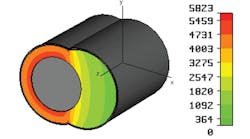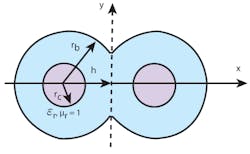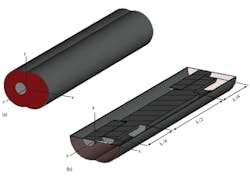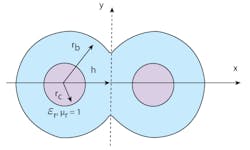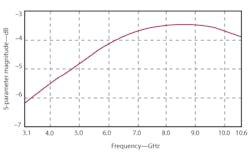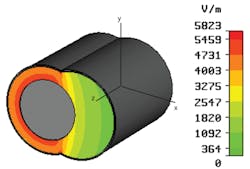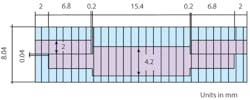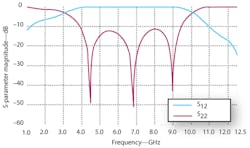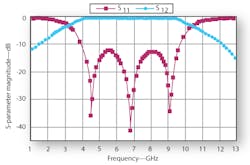Create UWB Filters With Coaxial Cables
Ultrawideband (UWB) communications offers great promise for voice, video, and high-data-rate transmissions, although key components will be needed for such systems. One of those components is the bandpass filter. Although traditional bandpass filters are designed and fabricated in planar form, it is also possible to create a UWB version using coaxial cables and coupled structures. The design approach is straightforward and the filter design can be readily analyzed by means of commercial electromagnetic (EM) simulation software.
Coaxial cables, of course, vary widely in electrical and mechanical properties, with some cables capable of excellent phase stability with temperature and flexure and some being more sensitive to variations in amplitude and phase performance with temperature. The use of coaxial cable for constructing a bandpass filter requires an understanding of the mechanical requirements for an antenna as well as the electrical charactertics of the cable, such as the power-handling capabilities and the relative dielectric constant, in order to achieve a desired characteristic impedance for the filter.
Although they differ from traditional planar circuits, coupled sliced coaxial cables are high-frequency transmission lines that can support a variety of compact circuits, including directional couplers and RF/microwave power dividers. For example, they have been used to build a microwave directional coupler.1 This kind of coupler has excellent performance in terms of high directivity, low VSWR, good isolation, excellent electromagnetic-interference (EMI) shielding, and high power-handling capability. Furthermore, since it is based on commercial semirigid coaxial cables and eliminates a mechanical housing, it is low in cost.2,3
Figure 1 shows the cross-section of a coupled line with sliced coaxial cables. The cable is assumed to be lossless with an inner conductor of radius rc and an outer conductor of radius rb. Dielectric material with relative dielectric constant εr fills the inside of the cable. A portion of each cable is cut out and two cut cables are used to form a coupled line (Fig. 2). The cut depth, u, as represented by h on the cross-sectional diagram can be found by the following equation:
u = cos−1(h/rb)/ cos−1(rc)/ rb)
2. These views depict (a) a three-dimensional schematic representation and (b) a longitudinal section of the proposed UWB bandpass filter.
In ref. 4, a numerical tool under the FreeFEM (www.FreeFEM.org) environment5 was used to analyze the electromagnetic (EM) parameters for sliced coaxial cables. This numerical tool can be easily adapted to study any other transverse-electromagnetic (TEM) or quasi-TEM structures.6 Also, the authors proposed rigorous analytical expressions for the primary parameters, including the inductance (L) and capacitance (C) matrices and the impedances of the even and odd modes for sliced coaxial cables, Z0e and Z0o, respectively.7
The analytical expressions—deduced from rigorous analyses by means of finite-element-method (FEM) and method-of-moments (MoM) approaches under the FreeFEM and LINPAR 8 environments, respectively—are convenient for all coupled sliced coaxial cables with a wide range of cut depths and outer-to-inner conductor radius ratios between 1.4 and 15. The authors proposed other analytical expressions9 to calculate the dimensions of sliced coaxial cables used to form compact microwave couplers at the characteristic impedances of 50 and 75 Ω typically used for low-loss transmissions in RF/microwave and cable-television (CATV) systems, respectively. Using these analytical expressions, an analysis can be readily implemented in modern commercial CAE software tools for the design of microwave and wireless components.
Since the release of the frequency band from 3.1 to 10.6 GHz for commercial purposes by the US Federal Communications Commission (FCC),10 UWB technology has sparked a great deal of interest for its potential in that band. Compact bandpass filters are essential components for UWB systems, but so far only planar structures have been reported for use in low power applications.11-15 As an alternative approach, the authors propose a novel and a simple compact UWB bandpass filter using sliced coaxial cables, convenient for high power applications requiring a small filter footprint. The filter can be easily designed and fabricated using the Transient Solver16 contained in CST MICROWAVE STUDIO® (CST MWS) from Computer Simulation Technology (www.cst.com) or other commercial EM software.
The design of the UWB filter is based on the use of impedance steps and coupled-line sections. A center frequency of around 6.85 GHz was selected, with bandwidth between 3.1 and 10 GHz. The insertion loss amounts to around 0.33 dB with better than 11.25 dB return loss across a wide frequency range (4.0 to 9.5 GHz). Simulated results show better than 20-dB stopband rejection performance to 12.5 GHz. For this bandpass filter with center frequency of 6.85 GHz and with a substrate with relative dielectric constant, εr, of 2.03, the sliced coaxial-cable filter is extremely compact, measuring only 6 × 8.04 × 33.4 mm.
Figures 2(a) and 2(b) show a three-dimensional (3D) schematic representation and longitudinal section, respectively, of the proposed UWB bandpass filter, assuming 50-Ω external feed lines. The filter structure includes an isolated sliced coaxial cable in the middle and a coupled line with sliced coaxial cables at the two ends.17 To achieve the UWB passband, the three sections of this filter are arranged with lengths of one-quarter, one-half, and one-quarter wavelength (λ/4, λ/2, and λ/4) as indicated in Fig. 2(b).
As part of this study on UWB coaxial-cable bandpass filters, the authors examined the design of an UWB filter with characteristic impedance of 50 Ω having an inner conductor of radius rc = 1 mm, outer conductor of radius rb = 3 mm, and relative dielectric constant of εr = 2.03. The cut depth, u, was varied from 0.90 to 0.99 to achieve a coupling coefficient of less than 5 dB for the sliced coaxial coupler (Fig. 3).
Building upon previous works based on FEM analysis, a coupling coefficient of 2 dB was obtained for a coaxial cable cut depth, h, of 1.02 mm. It yielded a characteristic impedance of approximately (Z0e x Z0o)0.5 = 23.4 Ω and the following primary EM parameters:
182.0 143.7
[L] = [ 143.7 182.0 ] (nH/m)
330.5 −261.1
[C] = [ −261.1 330.5 ] (pF/m)
For a length of one quarter wavelength, i.e., l = λ/4, and to verify that the designed coupler has a coupling coefficient of less than 5 dB from 3.1 to 10.6 GHz, the coupling coefficient of the sliced coaxial coupler of Fig. 3 was plotted versus frequency in Fig. 4, using the CST MWS Transient Solver. From these results, it appears that the coupling coefficient varies between 3.4 to 6.15 dB for that frequency range.
For the middle line of the UWB bandpass filter represented in Fig. 5, the outer conductor radius, rb, the cut depth, h, and the dielectric constant, εr, were kept constant, with values of 3 mm, 1.02 mm, and 2.03, respectively, while the inner conductor radius, rc , was varied to achieve a characteristic impedance, Z0, of 18 Ω, for the middle line. This value of Z0 was obtained for rc = 2.1 mm, yielding inductance and capacitance per unit length of 85.55 nH/m and 263.67 pF/m, respectively.4,6
6. This longitudinal section shows the geometrical characteristics of the designed UWB bandpass filter.
The CST MWS Transient Solver was applied to check the predicted electrical performance of the proposed filter characterized by the features marked in Fig. 6. Figure 7 provides plots of the simulated scattering parameters (S-parameters) for the filter from 1.0 to 12.5 GHz. These simulated responses are in reasonable agreement with measured and simulated results of planar bandpass filter structures. They also meet the requirements for high-power UWB applications per the FCC. The simulated results indicate passband insertion loss of about 0.33 dB with return loss of better than 11.25 dB from 4.0 to 9.5 GHz. The stopband rejection is better than 20 dB for frequencies to 12.5 GHz.
There are no numerical or experimental results in the scientific literature for this type of UWB filter based on the use of sliced coaxial cables. To check the results obtained by the CST MWS Transient Solver, it was necessary to “calibrate” those results by comparison with simulation results generated by other commercial software simulation tools. To accomplish this task, the authors performed simulations for the same geometrical and physical parameters using previous works and estimating the resulting scattering parameters of the UWB filter using MATPAR software.18 MATPAR is a software package that allows a use of MATLAB software from MathWorks (www.mathworks.com) to enlist paralallel computers for large analysis problems. Such extensions provide a dramatic increase in processing speed, sometimes as much as 30 times faster than running MATLAB on a single computer.
8. These scattering parameters of the designed UWB BPF were obtained using commercial math analysis software.
The results for coefficients S11 and S12 as functions of frequency for the proposed UWB filter structure are provided in Fig. 8. Figures 7 and 8 show that the responses obtained by the two numerical models (the CST and MATPAR software simulations) are in a good agreement. Although this comparison of simulations from two different software programs is not as valid as comparing the modeled simulation results to the measured results obtained from the analysis of a prototype filter, it does indicate that the basic design parameters for the filter are sound and should yield actual performance that is relatively close to either of the simulated performance plots.
In summary, sliced coaxial cables can be used to form a wideband bandpass filter capable of handling high power levels in a relatively small footprint. The filter, which measures just 6.00 x 8.04 x 33.40 mm, was fabricated by means of impedance steps and coupled-line sections. It was designed with the aid of the CST Transient Solver software, although other commercial EM simulation software programs can also be used with similar success. The compact bandpass filter features a broad bandwidth ranging from 3.1 to 10.0 GHz with better than 11.25 dB return loss and about 0.33 dB insertion loss over a large portion of its total passband. The design is inherently low in cost due to its humble material requirements and relatively simple to fabricate once dimensions are calculated.
References
1. H. An, O. Monti, R.G. Bossio, and K. Wu, “A novel type of low cost high performance coaxial cable coupler,” 25th European Microwave Conference (EuMG’95), 1995.
2. H. An, R.G. Bossio, and K. Wu, “Ultra wide band directional couplers with coaxial cable,” Canadian Conference on Electronics And Computer Engineering, 1995.
3. H. An, T. Wang, R.G. Bossio, and K. Wu, “Accurate closed form expression for characteristic impedance of coupled line with sliced coaxial cable,” IEE 1995.
4. N. Benahmed and M. Feham, “Finite element analysis of RF couplers with sliced coaxial cable,” Microwave Journal, Vol. 43, No. 11, November 2000, pp. 106-120.
5. www.Freefem.org.
6. N. Benahmed, M. Feham, and M. Kameche, “Finite element analysis of planar couplers,” Applied Microwave & Wireless, Vol.12, No. 10, October 2000, pp. 28-38.
7. N. Benahmed and M. Feham, “Rigorous analytical expressions for electromagnetic parameters of transmission lines: Coupled sliced coaxial cable,” Microwave Journal, Vol. 44, No. 11, November 2001, pp. 130-138.
8. A.R. Djordjevic, M.B. Bazdar, and T.K. Sarkan, LINPAR for windows: Matrix parameters of multiconductor transmission lines, Software and user’s manual, Artech House, Norwood, MA, 1999.
9. N. Benabdallah, N. Benahmed, S. Seghier and R. Bouhmidi, “Sliced coaxial cables form compact couplers,” Microwaves and RF, Vol. 46, No. 7, July 2007, pp. 90-94.
10. FCC, “Revision of Part 15 of the Commission’s Rules Regarding Ultra-Wideband Transmission System,” Technical Report ET-Docket 98-153, 14 February 2002.
11. A. Saito, H. Harada, and A. Nishikata, “Development of bandpass filter for ultra wideband (UWB) communication,” in Proceedings of the IEEE Conference on Ultra Wideband System Technology, 2003, pp.76-80.
12. L. Zhu, S. Sun, and W. Menzel, “Ultra-wideband (UWB) bandpass filters using multiple-mode resonator,” IEEE Microwaves and Wireless Components Letters, Vol. 15, No. 11, Nov. 2005, pp. 796-798.
13. J. Gao, L. Zhu, W. Menzel and F. Bögelsack, “Short-Circuited CPW Multiple-Mode Resonator for Ultra-Wideband (UWB) Bandpass Filter,” IEEE Microwave and Wireless Components Letters, Vol. 16, No. 3, March 2006, pp. 104-106.
14. M. Meeloon, S. Chaimool, and P. Akkaraekthalin, “Broadband bandpass filters using slotted resonators fed by interdigital coupled lines for improved upper stopband performances,” International Journal of Electronic Communications (AEU) (2008).
15. D. Kaddour, J.D. Arnould, and P. Ferrari, “Miniaturized semi-lumped UWB bandpass filter with improved out-of-band performances,” Microwave Journal, Vol. 53, No. 10, October 2010.
16. www.CST.com.
17. W. Menzel, L. Zhu, K. Wu, and F. Bogelsack, “On the design of novel compact broadband planar filters,” IEEE Transactions on Microwave Theory & Techniques, Vol. 51, No. 2, 2003, pp. 364-370.
18. A.R. Djordjevic, M. Bazdar, G. Vitosevic, T. Sarkar, and R.F. Harrington, Scattering parameters of microwave networks with multiconductor transmission lines, Artech House, Norwood,
MA, 1990.
